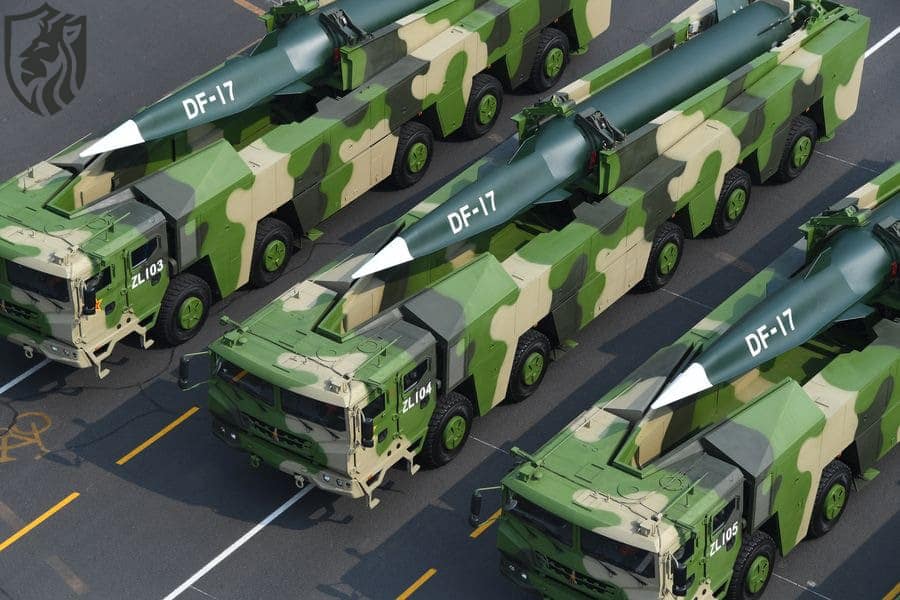
Chinese DF-17 Hypersonic Missile
Pakistan has reportedly entered early talks with China to acquire the DF-17 hypersonic missile system and its accessories. This system includes the DF-ZF hypersonic glide vehicle, designed for swift, evasive, and precise long-range strikes.

The announcement of this package, which came shortly after renewed tensions between Pakistan and India, demonstrates China’s growing role in reshaping the regional balance of power through military-industrial diplomacy.
“The Chinese military assistance package for Pakistan marks a major diplomatic and defense achievement under Prime Minister Shehbaz Sharif’s leadership,” according to an official government statement.
“High-tech military assets will greatly boost the capabilities of the Pakistan Air Force and its air defense systems, in line with the current high level of warfare,” according to the release.
According to the Stockholm International Peace Research Institute (SIPRI), China’s arms exports to Pakistan totalled more than $5.28 billion (RM23.2 billion) between 2018 and 2023, accounting for 63 percent of its total arms exports during that period.
This represents a 7% increase over the previous five-year period (2015–2020), when 74% of Pakistan’s arms imports came from China, highlighting the increasingly defensive nature of bilateral relations.
Mach 5 to Mach 10
If realised, Pakistan’s acquisition of the DF-17—which can deliver a hypersonic glide vehicle at speeds ranging from Mach 5 to Mach 10—would fundamentally alter the current deterrence balance between Islamabad and New Delhi. hypersonic missile accessories
With a range of 2,000–2,500 kilometres, the missile could reach nearly all of India’s strategic command centres, nuclear infrastructure, and high-value urban targets in a few minutes if launched from Pakistan.
This capability would reduce India’s reliance on fixed air and missile defense systems like the Russian S-400 Triumf and indigenous variants like the Barak-8 and Akash to a significant extent.
Geopolitically, the availability of the DF-17 in Pakistan will allow China to become more embedded in South Asia’s strategic landscape and employ its advanced military equipment to alter the balance of power in the region in Islamabad’s favour.
The DF-17’s ability to strike India’s mobile assets would give Pakistan more options during high-tempo military operations. For example, it could target Agni missile platforms or Rafale jets before they launch, shifting the conflict’s dynamics early.
BrahMos-II project
Furthermore, this capability would pressure India to accelerate its hypersonic weapons development in response. India might restart the stalled BrahMos-II project or deepen research ties with Russia and the United States.
Regionally, Pakistan’s adoption of hypersonic weapons would escalate the arms race and alter India’s strategic planning near Kashmir. This urgency would particularly affect Indian military operations along the Punjab and Kashmir borders.
Western analysts warn that Pakistan could pursue a “decapitation strike” strategy using the DF-17. Such a move would aim to paralyse India’s command-and-control before retaliation becomes possible—raising nuclear miscalculation risks.
Even in conventional war, the DF-17 poses serious danger with its speed and evasive flight path. It could bypass radar systems and destroy point defenses within seconds, enabling further strikes by other forces.
Moreover, Pakistan could modify the DF-17 for ships or road-mobile launchers, making it harder to track. This mobility would challenge American and Indian surveillance networks trying to monitor hypersonic threats.
Ultimately, acquiring the DF-17 pushes Pakistan’s military into the fifth-generation strike warfare domain. In this new space, speed, precision, and survivability matter more than ever.
What is a hypersonic glide vehicle (HGV)?
An HGV is a sophisticated re-entry warhead that detaches from a ballistic missile at a high altitude and glides through the atmosphere at hypersonic speeds (above Mach 5) while performing lateral and evasive manoeuvres to defeat missile defense systems.
Unlike traditional ballistic missiles, which follow predictable parabolic arcs, HGVs re-enter the atmosphere on flatter, low-altitude trajectories, making them much more difficult for radar systems and interceptors to track and neutralise.
A launch vehicle propels the HGV into the upper atmosphere, where it separates before reaching orbital velocity and glides quickly through the atmosphere before descending towards its target with little radar visibility.
Since existing air defense systems like THAAD, Patriot, Aegis, and S-400 are made to counter predictable, high-altitude ballistic threats, this combination of high speed and low flight paths makes them essentially useless.
The most prominent operational and developmental examples of this technology are the United States’ Common Hypersonic Glide Body (C-HGB), Russia’s Avangard, and China’s DF-ZF.

The DF-17 from China
China’s DF-17 hypersonic missile can strike targets over 2,500 kilometres away while remaining manoeuvrable during descent. It is recognised as the first hypersonic missile system ever deployed.
Russia’s Avangard, mounted on the RS-28 Sarmat ICBM, reportedly reaches speeds of Mach 27. Moscow claims the Avangard is completely immune to Western missile defenses.
President Vladimir Putin has publicly repeated this assertion. The United States is still developing its C-HGB despite testing delays and limited operational units.
HGVs mark a strategic shift towards Prompt Global Strike capabilities. This doctrine enables rapid destruction of key enemy assets with little or no warning.
Experts warn HGVs shorten decision-making time during crises. This is especially risky in regions like Taiwan, the Korean Peninsula, and South Asia.
A single miscalculation in these flashpoints could trigger rapid escalation. India sees a strategic gap and is investing in BrahMos-II and its own hypersonic projects.
It is also exploring cooperation with the United States, Japan, and Australia. Countries with operational HGVs gain a major asymmetric advantage. These systems allow deep strikes without relying on traditional ballistic missiles or strategic bombers.
But the proliferation of HGV technologies in unstable areas like the Korean Peninsula and the Middle East has sparked worries about destabilisation, especially as North Korea and Iran try to gain access through illegal or covert means.
More than just speed weapons, HGVs are strategic dominance tools that are redefining escalation control and deterrence theory.
They can carry both nuclear and high-explosive conventional payloads. Who can launch the first, fastest, and most impactful missile strike will be the decisive factor in the 21st-century arms race, not the quantity of missiles.






